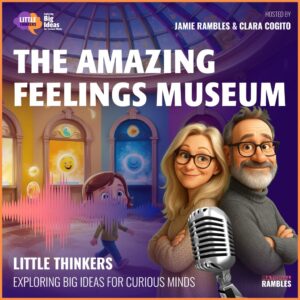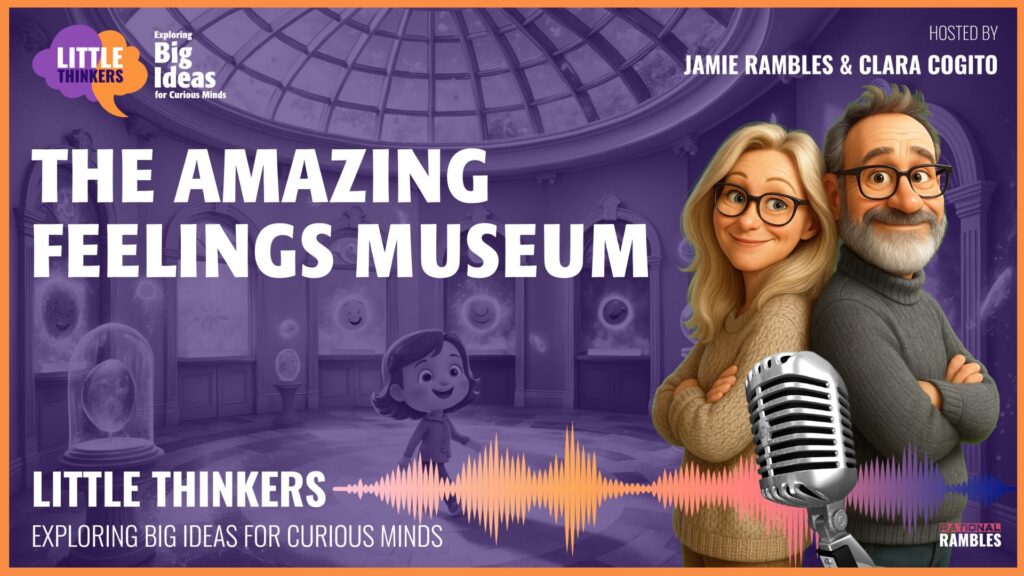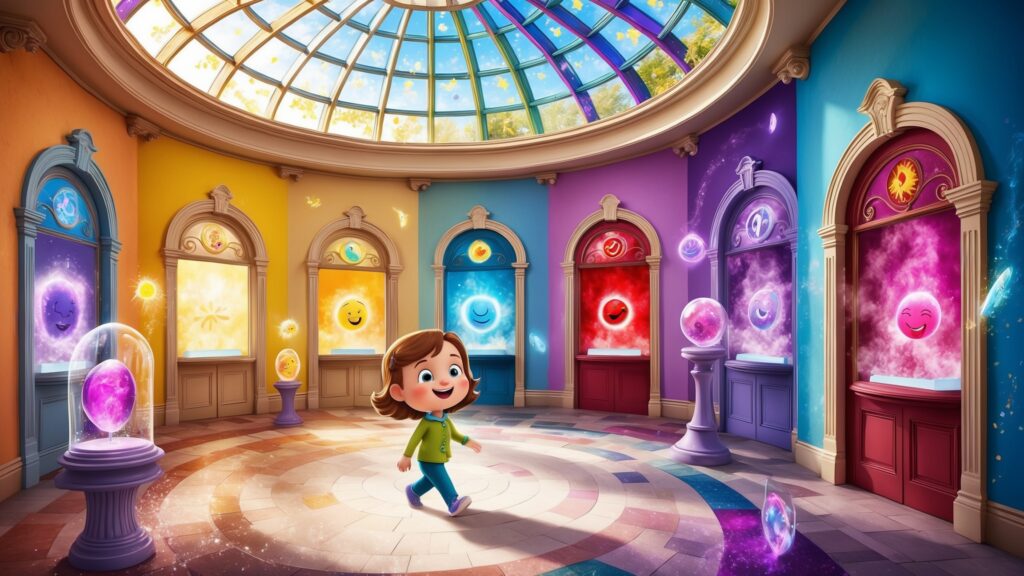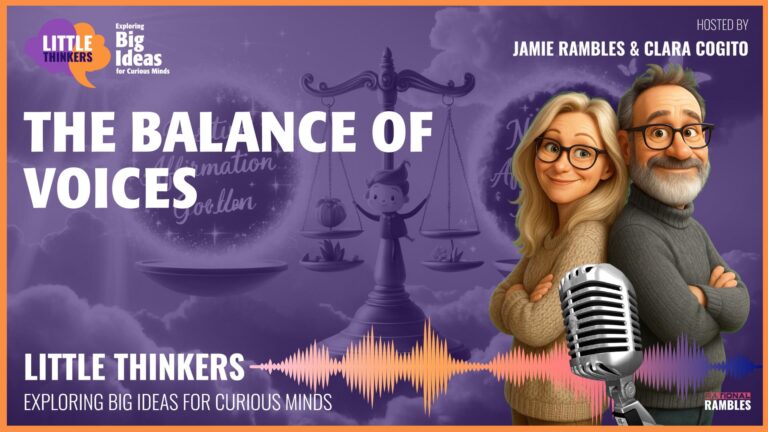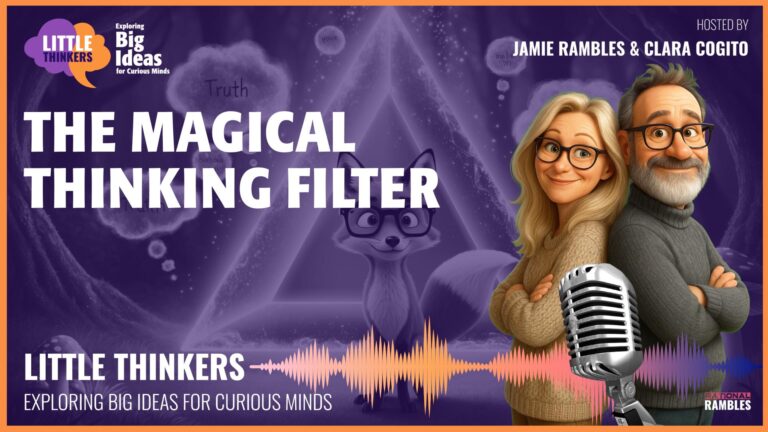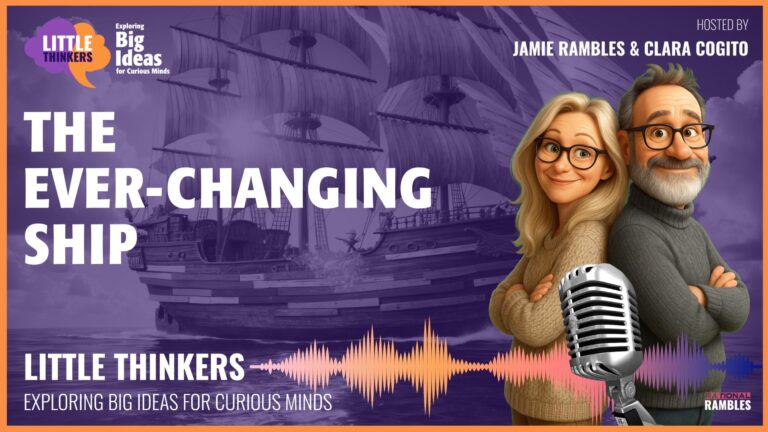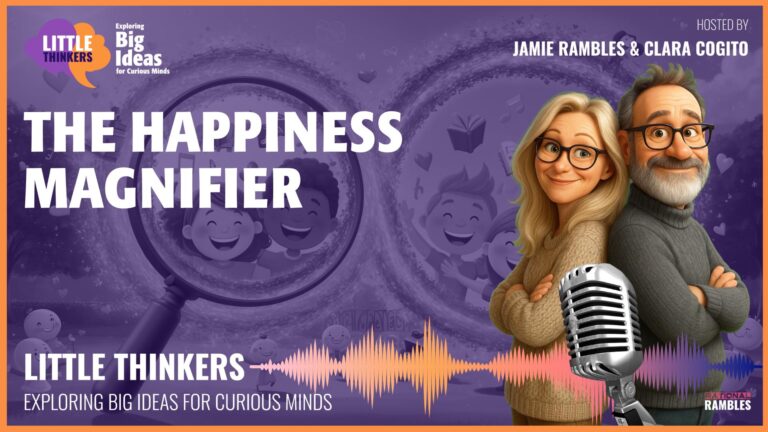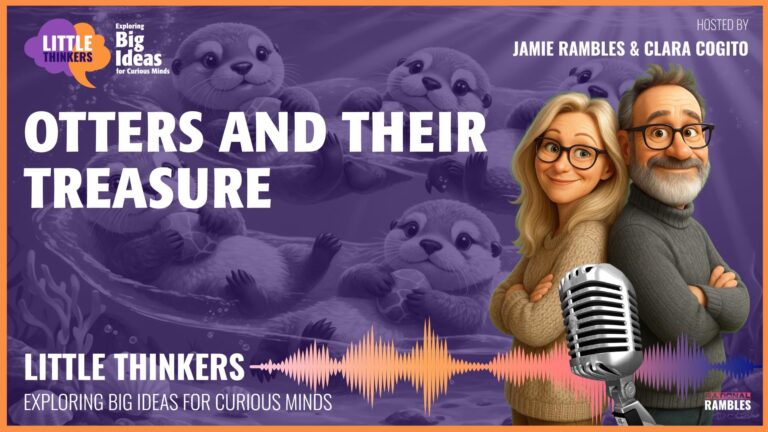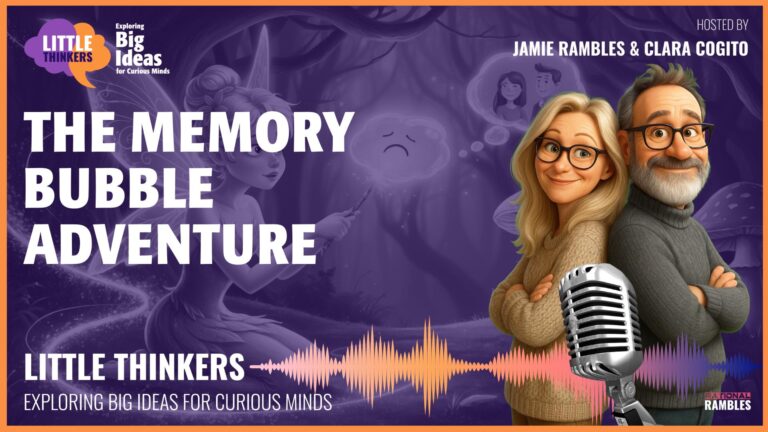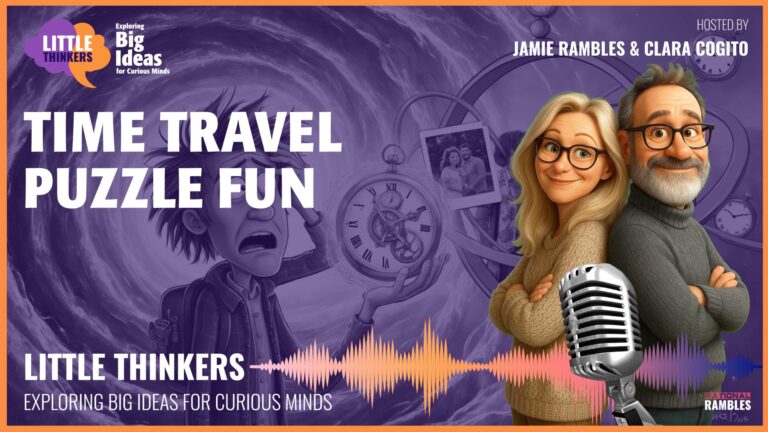The Amazing Feelings Museum Inside You!
What if your feelings had their own special rooms?
Have you ever felt really happy one minute and then super sad the next? Or maybe you’ve been so angry that your face got hot, but later you felt calm like a sleepy kitten? All these feelings are part of being human—just like having arms and legs!
But here’s a super cool idea to think about: What if all your feelings lived in a magical museum inside you? A place where each feeling has its very own special room that you can visit anytime! Let’s go exploring together!
Welcome to YOUR Feelings Museum!
Imagine walking through a big, colorful door into a museum that nobody else can see. This isn’t a regular museum with old paintings and dinosaur bones—it’s YOUR feelings museum! It’s filled with rooms that show all the different ways you feel.
At the entrance, there’s a giant map (like the ones you see at the shopping mall) that shows all the different feeling rooms you can visit. Some rooms might be big and others small. Some might be bright and others a bit darker. Every person’s feelings museum looks a little different!
What would YOUR museum map look like?
Grab a piece of paper and try drawing your own feelings museum map! Which feelings would get the biggest rooms? Which ones would be tiny? Have fun with it!
The Happiness Room: Bouncy and Bright!
Let’s visit the Happiness Room first! When you push open the door, WOW! It’s super bright with sunshine colors everywhere. The floor might be bouncy like a trampoline, and bubbles could be floating all around you!
In your Happiness Room, you might see pictures of all the things that make you smile—maybe your favorite toys, your pet, or eating ice cream with sprinkles on top. There might be slides and swings and all sorts of fun things to play with!
Think about it: What would YOUR happiness room look like? What special things would be inside it?
The Calm Room: Soft and Peaceful
Sometimes our feelings aren’t loud and jumpy—they’re quiet and peaceful. The Calm Room might have fluffy pillows everywhere and soft music playing. The lights would be gentle, not too bright, and maybe there’d be a comfy reading nook with your favorite books.
This is the room you visit when you need a break from noisy playgrounds or busy classrooms. It’s where you go when you want to take deep breaths and feel peaceful, like when you’re cuddling with a stuffed animal before bedtime.
Try this: Close your eyes for 10 seconds and imagine what your calm room looks like!
The Proud Room: Celebrating YOU!
There’s a special room in your feelings museum for when you do something awesome! The Proud Room might have ribbons and trophies showing all the times you were brave or worked really hard. Remember when you learned to ride a bike? Or when you helped your little brother tie his shoes? Those memories live here!
The Proud Room has a giant mirror so you can see yourself smiling. It reminds you that you can do amazing things, even when they seem hard at first!
Rooms for Trickier Feelings
Not all rooms in your feelings museum are filled with sunshine and rainbows. Some rooms might feel a little uncomfortable to visit—but that’s okay! These rooms are important too.
The Scared Room: Not So Scary After All
The Scared Room might seem dark when you first walk in. There might be shadows on the walls that look spooky. But here’s the cool part: when you turn on the light, you see those scary shadows are just made by friendly things—like a shadow that looked like a monster was really just made by a teddy bear!
This room teaches us that sometimes things aren’t as scary as they first seem. Like when you thought there was something under your bed, but it was just your slipper!
The Angry Room: Hot and Red!
Whoa! The Angry Room is probably super RED and feels hot like a sunny day. But look! It has soft pillows you can punch and clay you can squish. There might be drums to bang or paper to tear. This room gives you ways to let out your angry feelings without hurting anyone or breaking things.
Everyone feels angry sometimes—even grown-ups! The Angry Room helps us understand that feeling angry is okay, but we need safe ways to show it.
Why We Need ALL Our Feeling Rooms
Some people try to keep certain rooms in their feelings museum locked up tight. They don’t want to visit the Sad Room or the Jealous Room ever. They think if they ignore these feelings, they’ll go away.
But that’s not how feelings work! It’s like cleaning your room by shoving everything under the bed. Eventually, there’s no more space, and BOOM!—everything comes tumbling out in a big mess!
When we ignore feelings, they don’t disappear. They just get bigger and louder until we HAVE to pay attention—like when you try not to laugh and then get even worse giggles!
Did you know?
Even animals have feelings! Dogs get excited, cats get grumpy, and elephants can even feel sad when a friend is gone. Feelings are a part of life for all living creatures!
You Can Visit Without Moving In
The super cool thing about your feelings museum is that you can visit any room without having to LIVE there forever. You can go into the Sad Room, look around, maybe cry a little bit, and then leave when you’re ready. You don’t have to stay sad forever!
It’s like saying hello to your feelings: “Oh, hi there, Sad Feeling. I see you. You’re here because my friend couldn’t play today, and that’s disappointing. That makes sense.”
When we visit our feeling rooms and understand why they’re there, we actually learn from them! Even the not-so-fun ones have something important to teach us.
Rooms We Try to Avoid
Everyone has rooms they don’t like to visit. Maybe it’s the “Feeling Left Out” room, with lonely chairs where you sit when everyone else is playing and you weren’t invited. Or maybe it’s the “Embarrassed” room that shows times when you spilled milk all over your shirt or said something silly in class.
But guess what? Everyone has these rooms! Your friends, your teachers, even your parents have feeling rooms they find tricky to visit.
And if we’re brave enough to explore these rooms, we might find surprising things! In the “Feeling Left Out” room, there might be a corner that shows times when you played by yourself and had just as much fun. In the “Embarrassed” room, there might be reminders that making mistakes is how we learn new things!
Try this: Think of a feeling that’s hard for you to talk about. What might that room look like in your museum?
Your Very Own Tour Guide
Wouldn’t it be amazing if your feelings museum came with a friendly tour guide? Someone who helps you understand what you’re seeing in each room?
Good news—you already have this guide! It’s the wise part of your brain that helps you make sense of your feelings. Your inner tour guide might say things like:
- “This angry feeling is trying to show you that something isn’t fair.”
- “You’re just visiting this sad room, not moving in forever.”
- “Notice how proud you feel when you help someone else?”
Your tour guide is like a helpful friend who walks with you through every room, making sure you’re safe and helping you understand what you’re feeling.
Your Museum Grows With You!
The coolest thing about your feelings museum is that it changes as you grow up! Some rooms might get bigger, others smaller. You might discover brand new rooms you never knew existed!
When you were a tiny kid, your “Frustrated” room was probably HUGE because it was hard to do things by yourself. But as you got bigger, that room might have shrunk a bit as you learned to do more things on your own.
And one day, you might discover whole new rooms for feelings you’re just beginning to understand—like “nostalgia” (that funny feeling when you remember good times from when you were younger) or “gratitude” (the warm feeling of being thankful for good things in your life).
Amazing fact!
Scientists think humans can experience around 27 different emotions! That’s a lot of rooms in your feelings museum!
Feelings Are Connected!
Your feelings aren’t just separate rooms—they’re connected by hallways and doors! Sometimes being scared can lead right to feeling brave. Feeling sad might connect to feeling grateful for the people who give you hugs when you cry.
Imagine little pathways between all the feeling rooms, like secret passages in a castle. Sometimes you might zoom quickly from one feeling to another—like when you were nervous about a big game but then scored a goal and suddenly jumped into the “Excited” room!
The Most Important Room: YOU!
At the very center of your feelings museum is a special room called “You.” This room reminds you that no matter which feeling rooms you visit each day, you’re still YOU underneath it all.
Your “You” room is like the heart of the museum. It has all your favorite things, memories of good times, and reminders of the people who love you. This room stays steady and strong while your feelings come and go like visitors.
Remember: You HAVE feelings, but you are not your feelings. You’re the amazing person experiencing them!
Exploring Your Own Feelings Museum
Now it’s your turn to think about your feelings museum! Which rooms do you visit often? Which ones might need some exploring? Remember, it’s okay to peek into every room—that’s how we get to know ourselves better!
If you’re not sure where to start, begin with the fun rooms—like “Excited” or “Silly”—and then slowly check out the trickier ones when you feel ready. Your feelings museum is yours to explore at your own pace.
The next time you feel a big feeling bubbling up inside you, try to imagine walking into that room in your museum. Look around with curious eyes and ask yourself, “What can I learn here?”
Your Turn to Wonder
What do you think your feelings museum looks like? Would it be shaped like a castle? A spaceship? Or maybe a giant treehouse?
Which feeling room would you most like to visit today? Which one might need a little dusting off because you haven’t visited in a while?
Remember: All your feelings—even the uncomfortable ones—are important guides helping you understand yourself and the world around you. Your feelings museum is a magical place that only you can see, but it helps you connect with everyone else who has feelings too (which is everyone!).
Happy exploring, feeling explorer!
